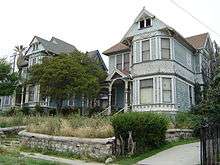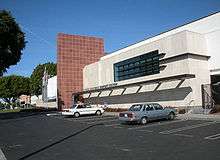Angelino Heights, Los Angeles
| Angelino Heights | |
|---|---|
| Neighborhood of Los Angeles | |
|
Victorian houses in Angelino Heights | |
 Angelino Heights Location in Los Angeles | |
| Coordinates: 34°04′13″N 118°15′17″W / 34.07028°N 118.25472°WCoordinates: 34°04′13″N 118°15′17″W / 34.07028°N 118.25472°W | |
| Country | United States |
| State | California |
| County | Los Angeles County |
| City | Los Angeles |
| Elevation[1] | 502 ft (153 m) |
Angelino Heights is a small quarter within the Echo Park district of Los Angeles, California. It is most notable for its high concentration of Victorian era residences. It lies at an elevation of 502 feet (153 m).[1]
Geography
Angelino Heights is bordered by Westlake on the south, Echo Park proper on the west and the north-west, and Elysian Park neighborhood on the east and north-east. Its boundaries are roughly Echo Park Avenue on the west, Sunset Boulevard on the north and east, and the Hollywood Freeway on the south. No major thoroughfares run through the district.
The neighborhood


Originally spelled Angeleno Heights, Angelino Heights is second only to Bunker Hill as the oldest district in Los Angeles. Founded in 1886, it was originally connected to the downtown mainline (which ran east to west on Temple Street) by the Temple Street Cable Railway and later by streetcars. Like Echo Park proper and Chinatown, it is known for its steep hills. The district contains many notable examples of Victorian architecture, particularly of the Eastlake and Queen Anne styles, and though found throughout the neighborhood, they are especially concentrated on Carroll Avenue. Two of these residences served as the houses used for the TV shows Charmed and Journeyman, used in the shows as San Francisco Victorian residences, and because of the picturesque nature of the neighborhood, they have served as the backdrop for countless motion pictures from the earliest days of cinema to the present. Traveling around the neighborhood, one also discovers that many other styles of architecturally significant homes are to be found here, such as Craftsman, Bungalow, Mission Revival, Art Deco, and Colonial Revival, to name a few.
A large swath of Angelino Heights was destroyed to build the Hollywood Freeway, which cut it off from Temple Street save an overpass at Edgeware Road.
Angelino Heights was the City of Los Angeles' first recognized historic district, or Historic Preservation Overlay Zone (HPOZ). Enacted in 1983 and spelled out in Angelino Heights' Preservation Plan, this zoning prohibits unsympathetic remodelling of historic houses and requires new construction to resemble original architecture in scale, massing and materials.
Police service

The Los Angeles Police Department operates the Rampart Community Police Station, which was located at 2710 West Temple Street, 90026, serving the neighborhood.[2] It has since moved east into a newly constructed facility at 1401 West 6th Street, the site of the former emergency receiving hospital.
Education

Angelino Heights is zoned to Los Angeles USD schools.[3]
All residents are zoned to Betty Plasencia Elementary School.
Some residents are zoned to King Middle School, while some are zoned to Virgil Middle School.
All residents are zoned to Belmont High School.
See also
- Carroll Avenue
- List of Los Angeles Historic-Cultural Monuments in Silver Lake, Angelino Heights, and Echo Park
References
External links
| Wikimedia Commons has media related to Angelino Heights, Los Angeles. |
- Los Angeles Times, West Magazine: "Angelino Heights" (12 Feb 2006)
- Los Angeles Times, Real Estate section, Neighborly Advice column: "Preserving L.A.'s past in Angelino Heights" (13 Feb 2005)
- Angelino Heights Trolley Line
- Historic 1300 Carroll Avenue/Morales House
- Angelino Heights Photo Gallery

